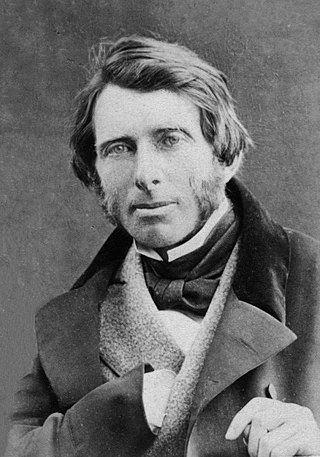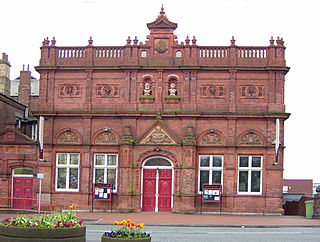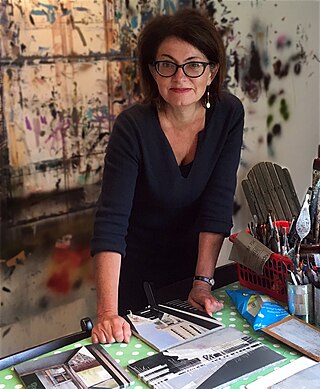
John Ruskin was an English polymath – a writer, lecturer, art historian, art critic, draughtsman and philanthropist of the Victorian era. He wrote on subjects as varied as art, architecture, political economy, education, museology, geology, botany, ornithology, literature, history, and myth.

Sir John Everett Millais, 1st Baronet was an English painter and illustrator who was one of the founders of the Pre-Raphaelite Brotherhood. He was a child prodigy who, aged eleven, became the youngest student to enter the Royal Academy Schools. The Pre-Raphaelite Brotherhood was founded at his family home in London, at 83 Gower Street. Millais became the most famous exponent of the style, his painting Christ in the House of His Parents (1849–50) generating considerable controversy, and he produced a picture that could serve as the embodiment of the historical and naturalist focus of the group, Ophelia, in 1851–52.

The Pre-Raphaelite Brotherhood was a group of English painters, poets, and art critics, founded in 1848 by William Holman Hunt, John Everett Millais, Dante Gabriel Rossetti, William Michael Rossetti, James Collinson, Frederic George Stephens and Thomas Woolner who formed a seven-member "Brotherhood" partly modelled on the Nazarene movement. The Brotherhood was only ever a loose association and their principles were shared by other artists of the time, including Ford Madox Brown, Arthur Hughes and Marie Spartali Stillman. Later followers of the principles of the Brotherhood included Edward Burne-Jones, William Morris and John William Waterhouse.

Weston Park Museum is a museum in Sheffield, South Yorkshire, England. It is one mile west of Sheffield city centre within Weston Park. It is Sheffield's largest museum and is housed in a Grade II* listed building and managed by Museums Sheffield. Until 2006 it was called Sheffield City Museum and Mappin Art Gallery.
Events from the year 1875 in art.
Meersbrook is a suburban district in the south-west of Sheffield, England bordered by Nether Edge to the west, Norton Lees to the south, Heeley to the north and the Meersbrook allotment site to the east. Until 1950 it was part of the Sheffield Ecclesall constituency and now forms part of the Sheffield Heeley constituency. The district falls within the Gleadless Valley ward of the city. The name comes from the stream, the Meers Brook, a tributary of the River Sheaf which means 'boundary brook' and in ancient times this, along with the River Sheaf was thought to have formed the boundary between the kingdoms of Northumbria and Mercia. It remained as the boundary between Yorkshire and Derbyshire into the 20th century. Meersbrook itself was once several small communities which have given many roads their names; Rush Dale, Carfield & Cliffe Field and in 1857 was known as Mears Brook.

The Millennium Gallery is an art gallery and museum in the centre of Sheffield, England. Opened in April 2001 as part of Sheffield's Heart of the City project, it is located in the city centre close to the mainline station, the Central Library and Graves Art Gallery, Sheffield Hallam University, and Sheffield Theatres. Designed by architects Pringle Richards Sharratt, the building is primarily made from concrete and glass, with a series of galleries extending from a central avenue, which connects Arundel Gate with Sheffield Winter Garden. In 2011, the gallery was listed as the 15th most-visited free attraction in the country by Visit England. It is managed by Museums Sheffield.

The Guild of St George is a charitable Education Trust, based in England but with a worldwide membership, which tries to uphold the values and put into practice the ideas of its founder, John Ruskin (1819–1900).

Gleadless Valley ward—which includes the districts of Gleadless Valley, Heeley, Lowfield, and Meersbrook—is one of the 28 electoral wards in City of Sheffield, England. It is located in the southern part of the city and covers an area of 4.5 km2. The population of this ward in 2011 was 21,089 people in 9,516 households. It is one of the five wards that form the Sheffield Heeley parliamentary constituency in the House of Commons. Gleadless Valley actually describes the valley that separates Hemsworth from Herdings, and is a broad area that covers several housing estates: Hemsworth, Herdings and Rollestone. Gleadless Valley is bordered by Gleadless and Norton.

The Ruskin School of Art is the Department of Fine Art at the University of Oxford, England. It is part of Oxford's Humanities Division.

Meersbrook Park is set on a steep hillside in Meersbrook, Sheffield, England, offering panoramic views over central Sheffield to the north. Within the park are two historic buildings: Bishops' House and Meersbrook Hall.
Sheffield, England, has a large population of amateur, working and professional visual artists and artworks.
Jack Smith was a British realist and, later, abstract artist.

Wednesbury Museum and Art Gallery is a purpose-built Victorian art gallery in Wednesbury in the West Midlands of England. It is notable for its Ruskin Pottery collection and for hosting the first public display of the Stuckism art movement.
Walkley is a suburb of Sheffield, England, west of Burngreave, south of Hillsborough and north-east of Crookes.
Julian Spalding is an English art critic, writer, broadcaster and a former curator. Considered to be a controversial maverick and outspoken critic of the art world, he has frequently contributed to arts, news and current affairs programmes on radio and TV.
John Riddy is a British photographer who came to the fore after his solo exhibition at Camden Arts Centre in 2000. He lives and works in London and has exhibited internationally since 1998.
Janet Barnes, is a British curator and former museum director. She was the chief executive officer of York Museums Trust from its founding in 2002 to 2015.

Mandy Payne is a member of the Contemporary British Painting group and is an artist with a primary interest in portraying the regeneration of inner city environments and the transitory nature of urban communities. Her themes include the contrasts between twentieth century inner-city social housing and modern gentrification.











